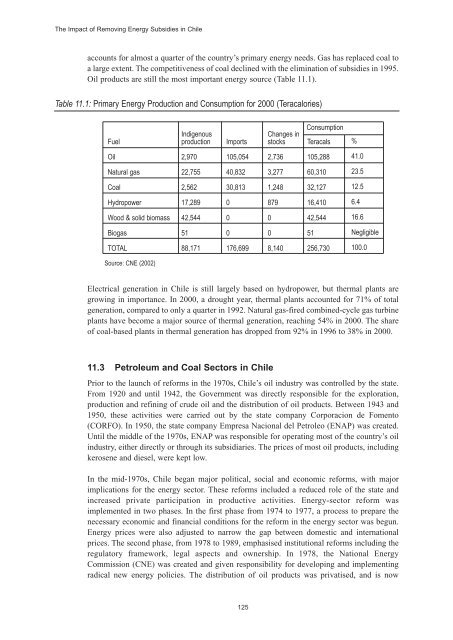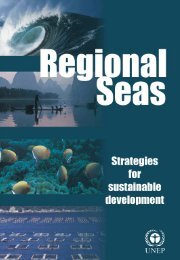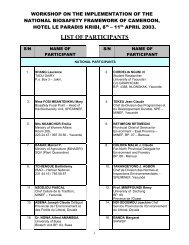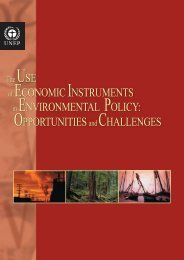Energy Subsidies: Lessons Learned in Assessing their Impact - UNEP
Energy Subsidies: Lessons Learned in Assessing their Impact - UNEP
Energy Subsidies: Lessons Learned in Assessing their Impact - UNEP
Create successful ePaper yourself
Turn your PDF publications into a flip-book with our unique Google optimized e-Paper software.
The <strong>Impact</strong> of Remov<strong>in</strong>g <strong>Energy</strong> <strong>Subsidies</strong> <strong>in</strong> Chile<br />
accounts for almost a quarter of the country’s primary energy needs. Gas has replaced coal to<br />
a large extent. The competitiveness of coal decl<strong>in</strong>ed with the elim<strong>in</strong>ation of subsidies <strong>in</strong> 1995.<br />
Oil products are still the most important energy source (Table 11.1).<br />
Table 11.1: Primary <strong>Energy</strong> Production and Consumption for 2000 (Teracalories)<br />
Fuel<br />
Indigenous<br />
production<br />
Imports<br />
Changes <strong>in</strong><br />
stocks<br />
Consumption<br />
Teracals<br />
%<br />
Oil<br />
2,970<br />
105,054<br />
2,736<br />
105,288<br />
41.0<br />
Natural gas<br />
22,755<br />
40,832<br />
3,277<br />
60,310<br />
23.5<br />
Coal<br />
2,562<br />
30,813<br />
1,248<br />
32,127<br />
12.5<br />
Hydropower<br />
17,289<br />
0<br />
879<br />
16,410<br />
6.4<br />
Wood & solid biomass<br />
42,544<br />
0<br />
0<br />
42,544<br />
16.6<br />
Biogas<br />
51<br />
0<br />
0<br />
51<br />
Negligible<br />
TOTAL<br />
88,171<br />
176,699<br />
8,140<br />
256,730<br />
100.0<br />
Source: CNE (2002)<br />
Electrical generation <strong>in</strong> Chile is still largely based on hydropower, but thermal plants are<br />
grow<strong>in</strong>g <strong>in</strong> importance. In 2000, a drought year, thermal plants accounted for 71% of total<br />
generation, compared to only a quarter <strong>in</strong> 1992. Natural gas-fired comb<strong>in</strong>ed-cycle gas turb<strong>in</strong>e<br />
plants have become a major source of thermal generation, reach<strong>in</strong>g 54% <strong>in</strong> 2000. The share<br />
of coal-based plants <strong>in</strong> thermal generation has dropped from 92% <strong>in</strong> 1996 to 38% <strong>in</strong> 2000.<br />
11.3 Petroleum and Coal Sectors <strong>in</strong> Chile<br />
Prior to the launch of reforms <strong>in</strong> the 1970s, Chile’s oil <strong>in</strong>dustry was controlled by the state.<br />
From 1920 and until 1942, the Government was directly responsible for the exploration,<br />
production and ref<strong>in</strong><strong>in</strong>g of crude oil and the distribution of oil products. Between 1943 and<br />
1950, these activities were carried out by the state company Corporacion de Fomento<br />
(CORFO). In 1950, the state company Empresa Nacional del Petroleo (ENAP) was created.<br />
Until the middle of the 1970s, ENAP was responsible for operat<strong>in</strong>g most of the country’s oil<br />
<strong>in</strong>dustry, either directly or through its subsidiaries. The prices of most oil products, <strong>in</strong>clud<strong>in</strong>g<br />
kerosene and diesel, were kept low.<br />
In the mid-1970s, Chile began major political, social and economic reforms, with major<br />
implications for the energy sector. These reforms <strong>in</strong>cluded a reduced role of the state and<br />
<strong>in</strong>creased private participation <strong>in</strong> productive activities. <strong>Energy</strong>-sector reform was<br />
implemented <strong>in</strong> two phases. In the first phase from 1974 to 1977, a process to prepare the<br />
necessary economic and f<strong>in</strong>ancial conditions for the reform <strong>in</strong> the energy sector was begun.<br />
<strong>Energy</strong> prices were also adjusted to narrow the gap between domestic and <strong>in</strong>ternational<br />
prices. The second phase, from 1978 to 1989, emphasised <strong>in</strong>stitutional reforms <strong>in</strong>clud<strong>in</strong>g the<br />
regulatory framework, legal aspects and ownership. In 1978, the National <strong>Energy</strong><br />
Commission (CNE) was created and given responsibility for develop<strong>in</strong>g and implement<strong>in</strong>g<br />
radical new energy policies. The distribution of oil products was privatised, and is now<br />
125
















